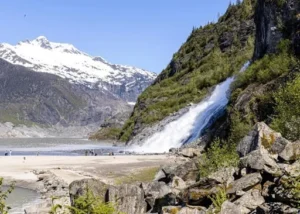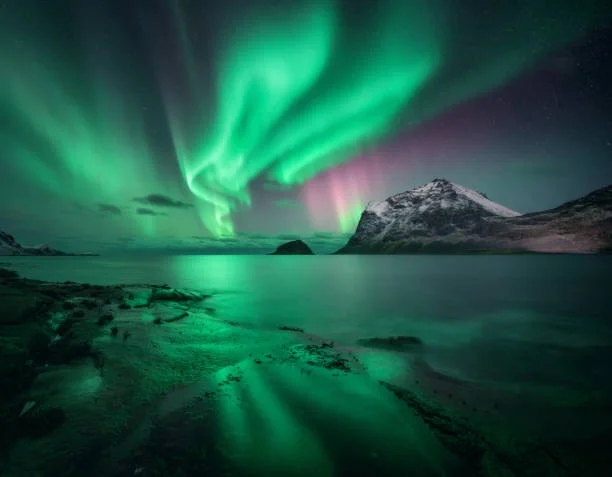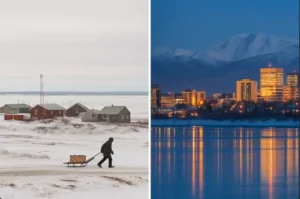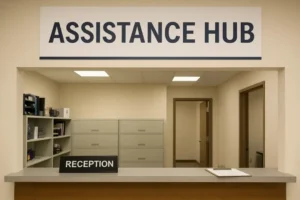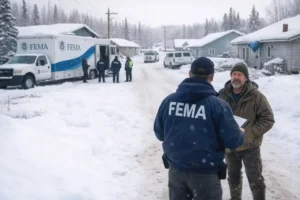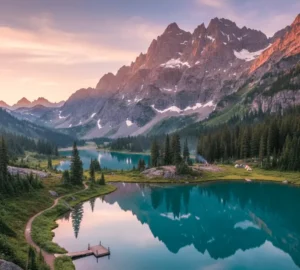Imagine standing under a vast Arctic sky as green and purple lights swirl above you. The Northern Lights, also known as the Aurora Borealis, are one of nature’s most stunning displays. Alaska, located under the Auroral Oval, offers some of the world’s best viewing opportunities. In this guide, we’ll cover the best times, locations, and expert tips to help you experience this breathtaking phenomenon.

Best Times and Places to View the Northern Lights in Alaska
When planning your Northern Lights in Alaska, timing and location are everything. Alaska’s position near the Arctic Circle makes it prime for aurora sightings, but understanding when and where to go can make all the difference in catching a clear, vibrant display.

⏰Best Time To See Northern Lights In Alaska⏰
The best time to witness Northern lights In Alaska is as Follows
Optimal Months:
The Northern Lights forecast for Alaska shows the best viewing between late September and early April. During this period, Alaska experiences longer nights, giving you extended darkness ideal for aurora visibility. Thanks to clearer skies and slightly warmer weather, March is often a top choice among travelers.
Best Hours
: Aim to be out between 10 PM and 2 AM for the brightest displays. However, auroras can appear anytime during the dark hours, so staying out longer may increase your chances.
Moon Phases
: A new moon or night with minimal moonlight improves visibility, as less ambient light allows the aurora colors to stand out more vibrantly against the night sky.

🏔️Best places to see northern lights in Alaska🏔️
Alaska offers the best Northern Lights viewing spots for the Ultimate Experience.
1. Fairbanks
Known as one of the most reliable spots for viewing the aurora, Fairbanks is just 150 miles south of the Arctic Circle. With clear skies and tour options that cater to Aurora chasers, this city offers one of the best Northern Lights experiences.
2. Coldfoot
A remote, off-the-grid experience is ideal for adventurers seeking solitude and breathtaking views.
3. Anchorage
Anchorage is another excellent base for Northern Lights seekers. Though closer to the coast, the city has plenty of dark, open spaces perfect for catching the Northern lights. Venture out to places like Eagle River or Girdwood to escape city lights.
4. Denali National Park
Imagine viewing the Northern Lights over the iconic landscape of Denali. The park’s vast wilderness provides a serene, undisturbed backdrop that amplifies the magic of the aurora.
5. Nome
For a more remote adventure, head to Nome. With its wide-open spaces and clear night skies, Nome is an incredible location for viewing the Northern Lights without the interference of city lights.
Budget Breakdown:
| Expense | Estimated Cost |
|---|---|
| Flights to Alaska | $300 – $800 |
| Hotels/Lodging (3 nights) | $300 – $1,200 |
| Northern Lights Tour | $100 – $400 |
| Food & Transportation | $100 – $300 |
| Total Cost | $800 – $2,700+ |

There is witnessing the Northern Lights, and then there is seeing the incredible aurora whilst upside downscaling a moonlit glacier!
Becky Pemberton
Packing Essentials for Witnessing the Aurora Borealis (Northern Lights)
To ensure a comfortable and enjoyable experience, pack the following items:
Clothing
- Thermal layers: Pack warm, breathable base layers (top and bottom) to keep you insulated.
- Insulated jacket and pants: A waterproof and windproof outer layer will protect you from harsh weather conditions.
- Warm hats and gloves: Choose items made from materials like wool, fleece, or synthetic fabrics that provide good insulation.
- Scarf or neck gaiter: Add an extra layer to protect your neck from the cold.
- Warm socks: Bring several pairs to change into if your feet get wet.
- Insulated, waterproof boots: With good grip to handle icy or snowy surfaces.
Accessories
- Camera: To capture stunning photos of the Aurora Borealis. Don’t forget extra batteries, a tripod, and a camera lens with a wide aperture.
- Binoculars: For a closer look at the Northern Lights.
- Rechargeable batteries: For your camera, phone, or other devices.
- Power bank: To keep your devices charged.
- Aurora forecast app: Download an app like Dark Sky or Aurora Service Europe to stay updated on Aurora activity.
Miscellaneous
- Snacks and water: Pack energy-rich snacks and a thermos with hot beverages to keep you warm and energized.
- First-aid kit: A basic kit with essentials like pain relievers, band-aids, and antacids.
- Headlamp or flashlight: In case you’re out in the dark.
- Travel documents: Ensure you have the necessary visas, travel insurance, and health insurance documents.
- Emergency shelter and warmth: A lightweight emergency blanket and a warm emergency bivvy sack (in case of unexpected weather changes).
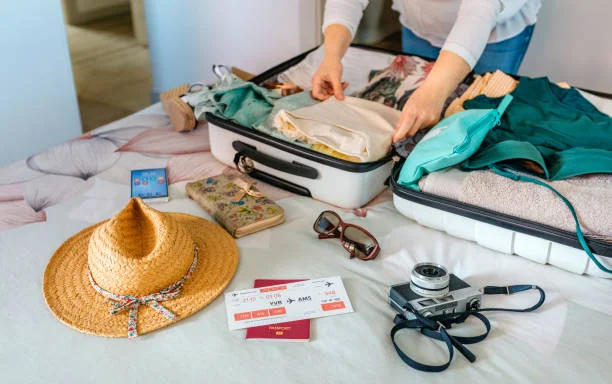
Travel Accommodations for the Best Aurora Views
For a unique and unforgettable Northern Lights experience, consider staying at one of Alaska’s specialized hotels that offers Northern Lights wake-up calls, viewing packages, and optimal viewing locations. Some hotels, like the Aurora Expeditions’ Northern Lights Lodge, offer guaranteed viewing packages. These hotels often provide warm and cozy amenities like hot tubs and fireplaces to enhance the viewing experience. By staying at one of these hotels, you can maximize your chances of witnessing the breathtaking beauty of the Northern Lights in Alaska. Here are some top options, ranging from cozy cabins to luxurious hotels, that put you near prime viewing spots.
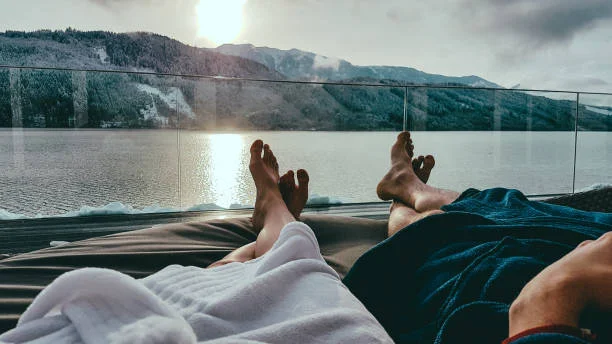
1. Aurora Borealis Lodge – Fairbanks
Located just north of Fairbanks, the Aurora Borealis Lodge is renowned for its clear Northern Lights views. In Fairbanks, visitors can expect to see the Northern Lights about 90% of the time if they stay for three nights and actively seek them out during late evening hours. Set away from city, this lodge offers spacious rooms with large windows, allowing guests to catch the aurora’s glow from their rooms. It’s a favorite for photographers and those who want to enjoy the aurora comfortably.
2. Chena Hot Springs Resort – Fairbanks Area
For a unique experience, stay at Chena Hot Springs Resort, where you can enjoy geothermal hot springs while waiting for the aurora to appear. Located about 60 miles from Fairbanks, the resort offers northern light tours, allowing guests to see the aurora in one of Alaska’s most scenic and serene settings.
3. Northern Sky Lodge – Ester
Situated near Ester, Alaska, Northern Sky Lodge is a cozy, family-owned lodge known for its expansive, open views of the aurora. With minimal light pollution, this spot is ideal for a quiet, intimate experience with the Northern Lights.
4. Sheldon Chalet – Denali National Park
If you’re seeking luxury with an unforgettable view, Sheldon Chalet, located within Denali National Park, offers high-end accommodations with a front-row seat to the aurora. Accessible only by helicopter, it’s a remote and exclusive experience that combines stunning landscapes and top-tier comfort.
5. Borealis Basecamp – Fairbanks Area
For a truly immersive experience, Borealis Basecamp offers glass-roofed igloos to view the Northern Lights from the warmth of your bed. Located outside Fairbanks, this unique stay combines the thrill of aurora viewing with the comfort of private igloo suites.
6. Alaska Range Motel– Healy
Alaska Range Lodge, located in Healy near Denali National Park, offers rustic cabins with spectacular views of the surrounding mountains and the Northern Lights. The lodge’s secluded location is ideal for aurora watchers who prefer a private and quiet environment.
7. Bethel Outdoor Adventure and Campground – Bethel
For those who prefer an outdoor experience, the Bethel Outdoor Adventure and Campground provides simple, cozy cabins with clear, unobstructed views of the northern skies. Bethel’s location, away from city, makes it a fantastic spot for seeing the aurora, especially for those seeking a more budget-friendly stay.
8. Talkeetna Alaskan Lodge – Talkeetna
Overlooking the Alaska Range, Talkeetna Alaskan Lodge is a charming hotel with comfortable rooms and a deck offering breathtaking views of Denali and the Northern Lights. The lodge’s position near Denali provides a unique backdrop for aurora viewing.
9. Eleven Winterlake Lodge – Remote Wilderness Location
Accessible only by small plane, Winterlake Lodge is a remote luxury lodge that offers incredible aurora viewing in a peaceful, isolated setting. With guided tours and exceptional amenities, this lodge offers a perfect mix of adventure and relaxation in a stunning wilderness.
10. Alaska Log Cabins on the Pond – Fairbanks Area
These rustic log cabins near Fairbanks offer the charm of a cabin stay with all the amenities you need. With minimal nearby light pollution, guests can step outside and enjoy an unfiltered view of the Northern Lights over a peaceful pond.
Camping experience of the Northern Lights
For a more immersive and adventurous experience, camping is a great way to see the Northern Lights in Alaska. Many campsites, such as the Chena River State Recreation Area and the Denali National Park and Preserve, offer stunning night sky views. To increase your chances of witnessing the Northern Lights, consider camping during the peak season (September to mid-April) and look for campsites with minimal light pollution. Pack warm clothing, a camera, and a portable charger to capture the moment. With the right gear and a little luck, camping under the Northern Lights in Alaska can be an unforgettable experience.
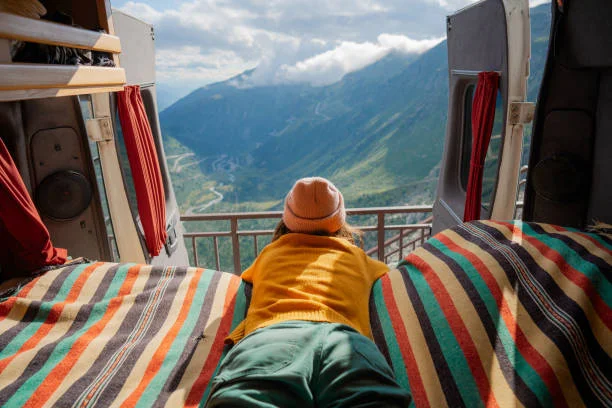
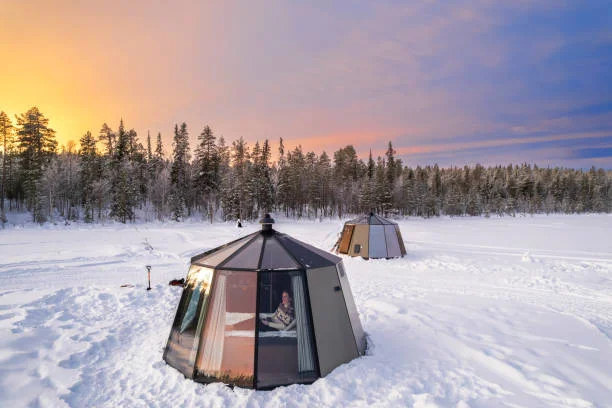
Igloo Hotel
Alaska offers a unique opportunity to witness the breathtaking Northern Lights while staying in an igloo hotel or visiting an igloo village, such as Chena Hot Springs Resort and Coldfoot Camp.
How to Maximize Your Aurora Viewing Experience?
To increase your chances of witnessing the Northern Lights in their full glory, follow these essential tips:
- Check the Aurora Forecast: Use online tools such as the Geophysical Institute’s Aurora Forecast to monitor activity levels.
- Choose Dark Locations: Avoid luminescence lights by heading to remote locations or designated aurora-viewing spots.
- Be Patient. The auroras can appear anytime at night, so plan to stay outside for extended periods.
- Dress Warmly: Temperatures can plummet below freezing, so wear insulated clothing, thermal layers, and heated accessories.
- Bring the Right Gear: A good camera with manual settings, a tripod, and a wide-angle lens can help capture the lights effectively.

Northern Lights On Alaska Cruise
Experience the breathtaking beauty of the Northern Lights on an Alaska cruise. The Fairbanks and Anchorage areas offer optimal viewing opportunities from September to mid-April. A Northern Lights cruise typically begins in late August and runs through September, offering a unique combination of stunning landscapes, wildlife viewing, and Aurora displays. While there are no guarantees of apparent sightings, many cruises provide Northern Lights guarantees, ensuring passengers can rebook if the Aruoral-lights are not visible during their trip. With expert guides, warm hospitality, and breathtaking scenery, an Alaska Northern Lights cruise is an unforgettable adventure.
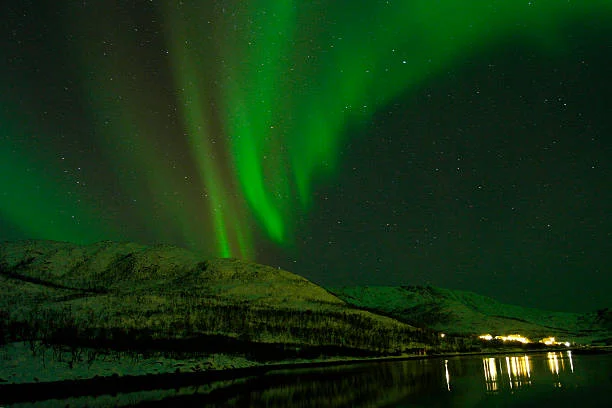
💡Suggestion💡
You can also experience the Northern Lights on a Train Trip. It is also an enticing experience. It can be a one-day trip and you can have a full exposure to the Northern Lights.
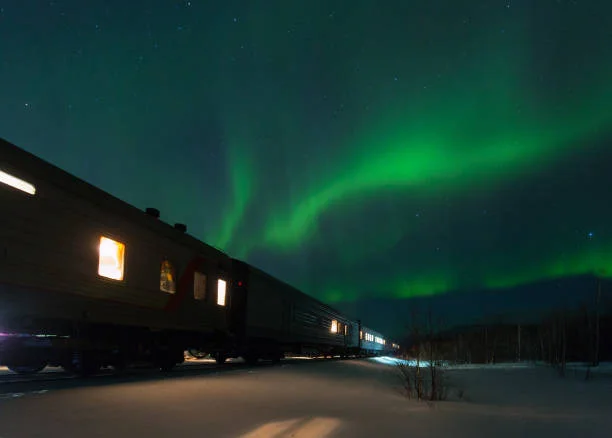
Common Mistakes to Avoid
- Booking only one night – The aurora is unpredictable; stay at least 3 nights for the best chances.
- Expecting the aurora every night – Weather and solar activity vary.
- Not dressing properly – Arctic temperatures require serious cold-weather gear.
- Using flash photography – This ruins night vision and affects camera settings.
- Not checking solar activity – Use the Aurora Forecast App or websites like spaceweather.com to track solar storms.
What Science Says About Northern Lights?
The Northern Lights, or aurora borealis, are a stunning display of light in the Earth’s atmosphere caused by the interaction between solar particles and Earth’s magnetic field. This phenomenon is driven by complex processes that begin on the sun and end with a captivating light show in the night skies near the poles.
1. The Role of the Sun
The Northern Lights begin with the sun. Periodically, the sun releases bursts of charged particles, known as solar winds, through solar flares and coronal mass ejections (CMEs). These solar winds carry high-energy particles like electrons and protons, which travel across space and can reach Earth in about 2 to 3 days.
2. Earth’s Magnetic Field as a Shield
As these charged particles approach Earth, they encounter Earth’s magnetic field, which acts as a protective shield, deflecting many particles. However, the field lines dip closer to the Earth’s surface near the magnetic poles, allowing some particles to enter the atmosphere. This is why auroras are commonly seen near the poles, where these magnetic field lines converge.
3. Particles Collide with Earth’s Atmosphere
When solar particles interact with gases in Earth’s atmosphere, ionization occurs. This involves electrons in these gases, which gain or lose energy, releasing photons (light particles). This release of photons creates the glow we see as the Northern Lights. The color and intensity of the aurora depend on the types of gases involved and the altitude of the collision.
4. Colors of the Northern Lights
- Green: The most common color, produced when solar particles collide with oxygen molecules at altitudes between 60 and 150 miles.
- Red: Seen less frequently, caused by oxygen at higher altitudes (above 150 miles), requiring more energy for these rare red emissions.
- Purple and Blue: Produced when excited nitrogen molecules create a blue or purple aurora at lower altitudes.
5. Magnetic Storms and Auroras
During periods of high solar activity, such as solar storms, more enormous bursts of charged particles reach Earth, causing more intense and widespread auroras. These magnetic storms can expand auroral visibility to lower latitudes, allowing people in areas far from the poles to witness the Northern Lights.

How to Capture Northern Lights
Photographing the Northern Lights can be challenging but rewarding. Follow these essential tips to capture the Northern Lights:
- Use the Right Equipment
- Adjust Camera Settings
- Shoot in RAW Format
- Use a Remote Shutter Release
- Scout the Location in Advance
- Dress Warmly and Be Patient
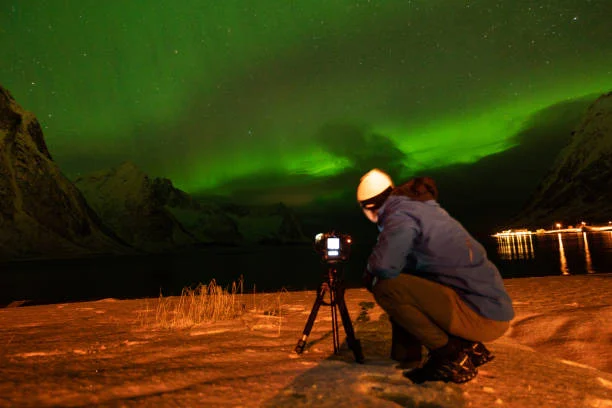
How to Capture the Northern Lights on Camera
Want to take breathtaking aurora photos? Follow these camera settings:
ISO: 800-3200
Aperture: f/2.8 or lower
Shutter Speed: 5-20 seconds
Tripod: Essential for stability
Use Manual Focus: Autofocus struggles in low-light conditions
Photography Tip: Use a wide-angle lens to capture the full expanse of the aurora and foreground scenery.
Cultural and Ethical Considerations
While chasing the Northern Lights, it’s essential to respect local communities and the environment:
- Respect Indigenous Cultures: Many Alaskan Native communities view the auroras with spiritual significance; always ask for permission before photographing people or sacred sites.
- Leave No Trace: Preserve natural beauty by minimizing your environmental footprint.
- Support Local Businesses: Choose local guides, accommodations, and services to contribute to the community.

Final Thoughts
Experiencing the Northern Lights in Alaska is a bucket-list adventure that offers breathtaking views and unforgettable memories. With careful planning, the right locations, and patience, you can witness this awe-inspiring natural phenomenon in all its glory.
Witnessing the Northern Lights doesn’t have to break the bank. Consider visiting destinations like Fairbanks and Alaska, which offer affordable accommodations and Northern Lights packages. Look for budget-friendly options like camping, hostels, or guesthouses, and take advantage of free or low-cost viewing spots like national parks or beaches. Additionally, consider traveling during the shoulder season (April or September) when prices are lower and the lights are still visible. With some planning and flexibility, you can experience Northern Lights without overspending.
So, are you ready to embark on your Northern Lights adventure? Pack your bags, watch the forecast, and prepare for a dazzling display in the Alaskan skies!
FAQs
When can you see the northern lights in Alaska
Late September to early April, especially from 10 PM to 2 AM.
Which part of Alaska is best for Northern Lights viewing?
Fairbanks is ideal, along with remote areas like Denali and Nome.
What camera settings should I use to photograph the aurora?
Use a wide aperture (f/1.4–f/2.8), ISO 800-1600, and a shutter speed of 5-20 seconds.
How cold does it get during the Northern Lights season in Alaska?
Temperatures can drop to -20°F (-29°C) or lower, especially in Fairbanks.
Are there guided Northern Lights tours available?
Yes, various guided tours operate from Fairbanks and Anchorage.
Can I see the Northern Lights without any special equipment?
There is no equipment to view them, but binoculars can enhance the experience.
What should I do if I encounter wildlife while viewing the aurora?
Stay calm, keep your distance, and avoid sudden movements or loud noises.
How far in advance should I plan a trip to see the Northern Lights?
Plan 6-12 months for the best accommodations and tours.

